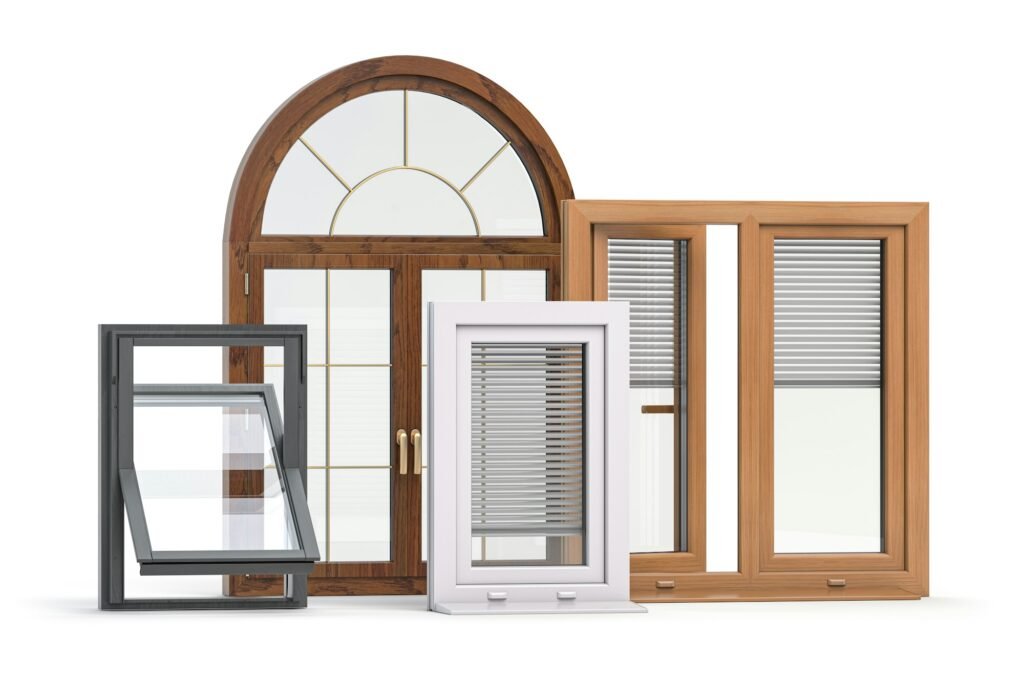Introduction
Windows are an essential part of any building, providing natural light, ventilation, and a connection to the outdoors. The way a window opens can significantly impact its functionality, appearance, and ease of use. In this guide, we will explore various window opening styles, making it easy to understand their differences, advantages, and ideal applications.
Common Window Opening Styles

- Casement Windows
- Sliding Windows
- Double-Hung and Single-Hung Windows
- Awning Windows
- Hopper Windows
- Fixed Windows
- Bay and Bow Windows
Casement Windows
Description:
- Casement windows are hinged on one side and open outward, much like a door. They are operated using a crank mechanism.
Advantages:
- Ventilation: Provide excellent ventilation as the entire window area can be opened.
- Energy Efficiency: Offer a tight seal when closed, improving energy efficiency.
- Unobstructed View: Provide a clear view with no middle sash.
Ideal Applications:
- Perfect for areas where you want maximum ventilation, such as kitchens and living rooms.
Comparison:
- Think of a casement window like a door. When you open a door, you get a wide, unobstructed entryway, similar to how casement windows provide a large opening for air to flow through.
Sliding Windows
Description:
- Sliding windows open horizontally by gliding along a track. They consist of two or more sashes, with at least one moving sash.
Advantages:
- Space-Saving: Do not require extra space to open, making them ideal for areas with limited space.
- Easy Operation: Simple to open and close, often with just a push or pull.
Ideal Applications:
- Ideal for rooms where space is limited, such as bathrooms, kitchens, or walkways.
Comparison:
- Imagine sliding a patio door open; sliding windows operate on a similar principle, providing easy access without requiring outward or inward space.
Double-Hung and Single-Hung Windows
Description:
- Double-hung windows have two sashes that can move up and down. Single-hung windows have one fixed sash (usually the top one) and one movable sash (usually the bottom one).
Advantages:
- Versatile Ventilation: In double-hung windows, both sashes can be opened for versatile ventilation.
- Easy Cleaning: Some double-hung windows allow the sashes to tilt inward for easy cleaning.
Ideal Applications:
- Suitable for almost any room, especially where traditional aesthetics are desired, such as bedrooms and living rooms.
Comparison:
- Think of double-hung windows like two vertically sliding panels on a cabinet. You can slide one or both panels to open and close the cabinet, similar to how you operate the sashes in double-hung windows.
Awning Windows
Description:
- Awning windows are hinged at the top and open outward, creating an awning-like effect when open.
Advantages:
- Weather Protection: Can be left open during light rain without allowing water in.
- Privacy: Often installed higher on walls, providing privacy while allowing ventilation.
Ideal Applications:
- Ideal for bathrooms, basements, and other areas where privacy and ventilation are important.
Comparison:
- Picture an awning over a shop door; it protects against the rain while allowing entry. Awning windows work similarly, letting in air but keeping out rain.
Hopper Windows
Description:
- Hopper windows are hinged at the bottom and open inward from the top.
Advantages:
- Excellent Ventilation: Provide good airflow when open.
- Basement Use: Commonly used in basements, where they can be positioned high on the wall.
Ideal Applications:
- Perfect for basements, bathrooms, or any area where an inward-opening window is suitable.
Comparison:
- Imagine a mailbox slot that opens downward. Hopper windows operate in a similar way, opening from the top and allowing air in.
Fixed Windows
Description:
- Fixed windows do not open. They are designed solely to provide light and views.
Advantages:
- Energy Efficiency: Completely sealed, providing excellent energy efficiency.
- Uninterrupted Views: Offer clear, unobstructed views.
Ideal Applications:
- Best used in spaces where ventilation is not needed but natural light and views are desired, such as hallways, stairwells, and large living areas.
Comparison:
- Think of a picture frame on a wall; it’s there to display the view without any moving parts. Fixed windows are similar, providing a permanent view without opening.
Bay and Bow Windows
Description:
- Bay windows consist of a central fixed window with two angled windows on either side. Bow windows are similar but have a curved structure with more windows.
Advantages:
- Increased Space: Create additional interior space, often used as a window seat or shelf.
- Natural Light: Allow more natural light into a room from multiple angles.
- Aesthetic Appeal: Enhance the architectural look of a home.
Ideal Applications:
- Ideal for living rooms, dining rooms, and master bedrooms where natural light and extra space are beneficial.
Comparison:
- Picture a panoramic photograph; bay and bow windows create a wide, expansive view similar to a panoramic shot, capturing more of the outside scenery.
Choosing the Right Window Style for Your Needs

- Consider the Room Function:
- Different rooms have different needs. For example, kitchens and bathrooms may benefit more from casement or awning windows for their ventilation properties, while living rooms and bedrooms might benefit from double-hung or sliding windows for ease of use and aesthetic appeal.
2. Think About Space Constraints:
- In tight spaces, sliding or fixed windows may be more practical as they don’t require additional space to open.
3. Assess Your Aesthetic Preferences:
- The style of the window should complement the overall architectural design of your home. Traditional homes may look best with double-hung or casement windows, while modern homes might favor sliding or fixed windows.
4. Consider Maintenance Needs:
- Some window styles, like double-hung windows, offer easier cleaning options. Think about how easy it will be to maintain and clean the windows.
5. Evaluate Energy Efficiency:
- All window styles can be energy efficient, but some may provide better seals and insulation. Casement windows, for example, often seal very tightly when closed.
6. Plan for Installation:
- Proper installation is key to the performance of any window. Ensure that the windows are installed by professionals to maximize their benefits in terms of energy efficiency, security, and noise reduction.
Conclusion
Choosing the right window opening style involves understanding the unique benefits and ideal applications of each type. Whether you prefer the classic functionality of double-hung windows, the space-saving design of sliding windows, or the excellent ventilation of casement and awning windows, there is a style to suit every need and preference. By considering factors such as room function, space constraints, aesthetics, maintenance, energy efficiency, and installation, you can select the perfect windows to enhance your home’s comfort, functionality, and appearance.
